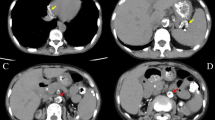Abstract
Idiopathic hypereosinophilic syndrome (HES) is a rare diagnosis defined by the World Health Organization as a persistent eosinophilia for 6 months and resulting in end-organ dysfunction. While many patients present with nonspecific symptoms, others will present with symptoms of the affected organs, most commonly those involving the heart, skin, or nervous system. Gastrointestinal or liver involvement is estimated to affect up to one-third of patients with HES, although patients with clinically significant disease are limited to case reports. This is the first report of a patient presenting with hepatitis and achalasia related to idiopathic HES.




Similar content being viewed by others
References
Gotlib J. World Health Organization-defined eosinophilic disorders: 2014 update on diagnosis, risk stratification, and management. Am J Hematol. 2014;89(3):325–37. doi:10.1002/ajh.23664.
Fauci AS, Harley JB, Roberts WC, Ferrans VJ, Gralnick HR, Bjornson BH. NIH conference. The idiopathic hypereosinophilic syndrome. Clinical, pathophysiologic, and therapeutic considerations. Ann Intern Med. 1982;97(1):78–92.
Weller PF, Bubley GJ. The idiopathic hypereosinophilic syndrome. Blood. 1994;83(10):2759–79.
Chusid MJ, Dale DC, West BC, Wolff SM. The hypereosinophilic syndrome: analysis of fourteen cases with review of the literature. Medicine (Baltimore). 1975;54(1):1–27.
Parrillo JE, Borer JS, Henry WL, Wolff SM, Fauci AS. The cardiovascular manifestations of the hypereosinophilic syndrome. Prospective study of 26 patients, with review of the literature. Am J Med. 1979;67(4):572–82.
Moore PM, Harley JB, Fauci AS. Neurologic dysfunction in the idiopathic hypereosinophilic syndrome. Ann Intern Med. 1985;102(1):109–14.
Kazmierowski JA, Chusid MJ, Parrillo JE, Fauci AS, Wolff SM. Dermatologic manifestations of the hypereosinophilic syndrome. Arch Dermatol. 1978;114(4):531–5.
Croffy B, Kopelman R, Kaplan M. Hypereosinophilic syndrome. Association with chronic active hepatitis. Dig Dis Sci. 1988;33(2):233–9.
Foong A, Scholes JV, Gleich GJ, Kephart GM, Holt PR. Eosinophil-induced chronic active hepatitis in the idiopathic hypereosinophilic syndrome. Hepatology. 1991;13(6):1090–4.
Nagamura N, Ueno S, Fujishiro H, Oonuma H. Hepatitis associated with hypereosinophilia suspected to be caused by HES that also presented with the pathological features of IgG4-related disease. Intern Med. 2014;53(2):145–9.
Aoyama T, Matsumoto T, Uchiyama A, Kon K, Yamashina S, Suzuki S, et al. Recurrent severe acute hepatitis caused by hypereosinophilic syndrome associated with elevated serum immunoglobulin G4 levels. Clin J Gastroenterol. 2014;7(6):516–22. doi:10.1007/s12328-014-0532-0.
Man F, Chiocca JC. Achalasia due to eosinophil infiltration: fact or fiction? Dig Dis Sci. 1993;38(8):1561.
Goldblum JR, Whyte RI, Orringer MB, Appelman HD. Achalasia. A morphologic study of 42 resected specimens. Am J Surg Pathol. 1994;18(4):327–37.
Tøttrup A, Fredens K, Funch-Jensen P, Aggestrup S, Dahl R. Eosinophil infiltration in primary esophageal achalasia. A possible pathogenic role. Dig Dis Sci. 1989;34(12):1894–9.
Krill JT, Naik RD, Vaezi MF. Clinical management of achalasia: current state of the art. Clin Exp Gastroenterol. 2016;9:71–82. doi:10.2147/CEG.S84019.
Minami H, Inoue H, Haji A, Isomoto H, Urabe S, Hashiguchi K, et al. Per-oral endoscopic myotomy: emerging indications and evolving techniques. Dig Endosc. 2015;27(2):175–81. doi:10.1111/den.12328.
Acknowledgments
Financial disclosure: none to report. No individuals participated in the writing of this case report other than those listed as authors above.
Author information
Authors and Affiliations
Corresponding author
Ethics declarations
Conflict of Interest:
The authors have nothing to disclose.
Human/animal Rights:
All procedures followed have been performed in accordance with the ethical standards laid down in the 1964 Declaration of Helsinki and its later amendments.
Informed Consent:
Informed consent was obtained from all patients for being included in the study.
Rights and permissions
About this article
Cite this article
Cheung, A.C., Hachem, C.Y. & Lai, J. Idiopathic hypereosinophilic syndrome presenting with hepatitis and achalasia. Clin J Gastroenterol 9, 238–242 (2016). https://doi.org/10.1007/s12328-016-0661-8
Received:
Accepted:
Published:
Issue Date:
DOI: https://doi.org/10.1007/s12328-016-0661-8




